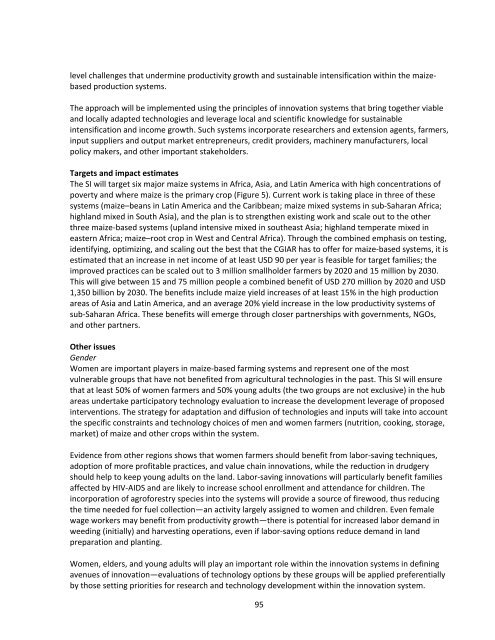Download - Maize
Download - Maize
Download - Maize
You also want an ePaper? Increase the reach of your titles
YUMPU automatically turns print PDFs into web optimized ePapers that Google loves.
level challenges that undermine productivity growth and sustainable intensification within the maizebased<br />
production systems.<br />
The approach will be implemented using the principles of innovation systems that bring together viable<br />
and locally adapted technologies and leverage local and scientific knowledge for sustainable<br />
intensification and income growth. Such systems incorporate researchers and extension agents, farmers,<br />
input suppliers and output market entrepreneurs, credit providers, machinery manufacturers, local<br />
policy makers, and other important stakeholders.<br />
Targets and impact estimates<br />
The SI will target six major maize systems in Africa, Asia, and Latin America with high concentrations of<br />
poverty and where maize is the primary crop (Figure 5). Current work is taking place in three of these<br />
systems (maize–beans in Latin America and the Caribbean; maize mixed systems in sub‐Saharan Africa;<br />
highland mixed in South Asia), and the plan is to strengthen existing work and scale out to the other<br />
three maize‐based systems (upland intensive mixed in southeast Asia; highland temperate mixed in<br />
eastern Africa; maize–root crop in West and Central Africa). Through the combined emphasis on testing,<br />
identifying, optimizing, and scaling out the best that the CGIAR has to offer for maize‐based systems, it is<br />
estimated that an increase in net income of at least USD 90 per year is feasible for target families; the<br />
improved practices can be scaled out to 3 million smallholder farmers by 2020 and 15 million by 2030.<br />
This will give between 15 and 75 million people a combined benefit of USD 270 million by 2020 and USD<br />
1,350 billion by 2030. The benefits include maize yield increases of at least 15% in the high production<br />
areas of Asia and Latin America, and an average 20% yield increase in the low productivity systems of<br />
sub‐Saharan Africa. These benefits will emerge through closer partnerships with governments, NGOs,<br />
and other partners.<br />
Other issues<br />
Gender<br />
Women are important players in maize‐based farming systems and represent one of the most<br />
vulnerable groups that have not benefited from agricultural technologies in the past. This SI will ensure<br />
that at least 50% of women farmers and 50% young adults (the two groups are not exclusive) in the hub<br />
areas undertake participatory technology evaluation to increase the development leverage of proposed<br />
interventions. The strategy for adaptation and diffusion of technologies and inputs will take into account<br />
the specific constraints and technology choices of men and women farmers (nutrition, cooking, storage,<br />
market) of maize and other crops within the system.<br />
Evidence from other regions shows that women farmers should benefit from labor‐saving techniques,<br />
adoption of more profitable practices, and value chain innovations, while the reduction in drudgery<br />
should help to keep young adults on the land. Labor‐saving innovations will particularly benefit families<br />
affected by HIV‐AIDS and are likely to increase school enrollment and attendance for children. The<br />
incorporation of agroforestry species into the systems will provide a source of firewood, thus reducing<br />
the time needed for fuel collection—an activity largely assigned to women and children. Even female<br />
wage workers may benefit from productivity growth—there is potential for increased labor demand in<br />
weeding (initially) and harvesting operations, even if labor‐saving options reduce demand in land<br />
preparation and planting.<br />
Women, elders, and young adults will play an important role within the innovation systems in defining<br />
avenues of innovation—evaluations of technology options by these groups will be applied preferentially<br />
by those setting priorities for research and technology development within the innovation system.<br />
95

















